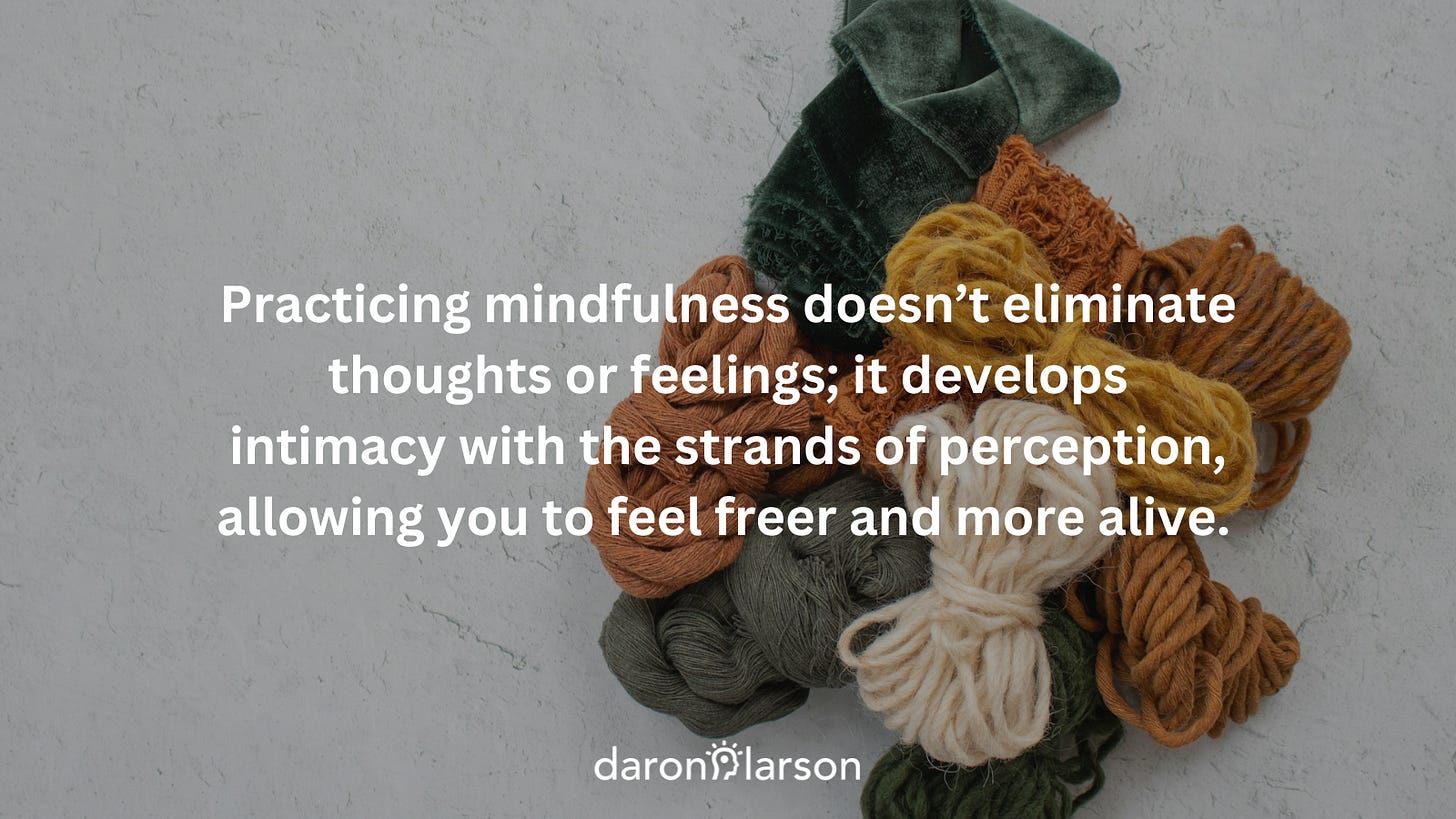This is the final part of a four-part series about being aware of thinking and feeling.
The poet Muriel Rukeyser observed,
“The universe is made of stories, not atoms.”1
To make sense of our lives and connect with others, we rely on the same elements we find in novels, plays, and films: heroes, villains, conflict, action, and resolution.
However, none of these narrative components could exist without the underlying “atoms” of perceptions needed to construct them:
words
images
feelings
The characters we read about in books or watch on screens could not exist without these sensory phenomena, and our own thoughts, memories, plans, and fantasies are assembled in a similar way.
When I think about starting kindergarten fifty-four years ago at Sunnyside Elementary in Wichita, Kansas, the salient memories are comprised of mental images, snippets of sounds and dialogue, and the emotional feeling. These same raw materials of sensory perception allow me to conjure scenes of unrequited love in high school, my marriage falling apart when my daughter was a baby, and picking up my grandson from daycare last week.
When I worry about the people I care about, speculate about where political polarization could lead, and wonder how my old age and death might play out, I’m producing private mental and emotional movies using internal talk, mental images, and feelings.
I know this sounds self-evident, but it’s at the core of what makes mindfulness practice both challenging, doable, and liberating.
Consider how much watching the news shares with worrying about the details of your own life. Visual and auditory elements are skillfully edited to evoke emotions and capture our attention. Unpleasant feelings such as anger, fear, and sadness create emotional discomfort that we instinctively want to avoid. When we come across stories that trigger these emotions, our minds naturally look for ways to alleviate the pain.
In our lives, devising realistic solutions to problems at home and in the workplace can be a time-consuming task. Sometimes solutions never come. The changes we hope for may be out of our control, and the strong desire for resolution can lead us into frustrating and unproductive thought patterns. Navigating our lives like characters navigate through chapters and scenes works well until it doesn’t.
Practicing mindfulness can teach us to shift our awareness away from our story problems, sometimes, to observe the underlying phenomena. While this sounds passive, it's the opposite. By learning to inhabit uncertainty at the phenomenal level, we become better prepared to handle the inevitable situations that remain unresolved for much longer than we would like.
This shifts the focus from the significance of dramatic events to the direct experience of how sensory phenomena behave, interact, and subside. It also enables us to redirect our problem-solving instincts, emphasizing what is within our control. By doing so, we can live in ways that are consistent with our values and ensure we get the rest we need to engage with the messy unpredictability of life.
By default, we subconsciously weave words, images, and feelings together to predict, reflect, and learn from our experiences. While we focus on the stories that emerge, the internal weaving process remains largely imperceptible to us. Mindfulness practice helps us untangle the strands of perception to transform the ways we respond to our experiences.
Observation at this level is assumed to be completely ineffable. It’s not. The intangible aspects of subjective experience become tangible and therefore observable, but inviting adults to observe their own subjectivity is like asking fish to become aware of the water they swim in.2
To tease out the elusive strands of perception while watching the news, focus on one phenomenal component at a time.
Mute the sound and view the stream of images.
Close our eyes and listen to the rhythm and flow of speech.
Pay attention to bodily sensations that convey emotional feelings.
You can apply this perspective to your personal experiences as well. For instance, consider times when you find yourself worrying, obsessing, or unable to sleep at night. Instead of trying to suppress these internally-produced newsfeeds, focus your awareness on one specific aspect at a time., focus your awareness on one specific aspect at a time.
Locate the area where mental images appear.
Find the space where verbal thoughts can be heard.
Scan the body for signs of emotional flavors related to your concerns.
In both scenarios, you'll quickly realize that it's impossible to completely isolate one aspect from the others. The process resembles teasing out one strand while avoiding tangling with the others. This method of imperfect untangling is sufficient to help you understand how subjective experience operates.
This won’t make difficult stories go away, but it can change how you relate to difficulty and ease over time.3 We often believe that what we want is a life filled with complete physical, mental, and emotional comfort. However, maybe what we really yearn for is an ability to interfere less with the natural flow of our sensory experiences and internal perceptions. Perhaps a part of us wonders if it would be more fulfilling to decide what to focus on, rather than habitually yielding to external pressures. Maybe we simply want to feel more alive during the short time we have to live.
Through consistent practice, you can gradually reduce the need for all the narrative elements in our ordinary lives to be ideal, certain, comfortable, entertaining, and unchanging. You can cultivate your attention to feel more at home in your mind, emotions, and this chapter of your life.
Exercise
This exercise sharpens your ability to notice the presence of mental images, verbal thoughts, and emotional feelings.
It integrates the themes explored in three previous exercises:
Circumstances for learning this attention exercise
preparing to share an idea in a meeting
after a presentation or challenging conversation
planning a vacation or replaying one that went badly
Listen to this episode with a 7-day free trial
Subscribe to Phenomenal Awareness to listen to this post and get 7 days of free access to the full post archives.














